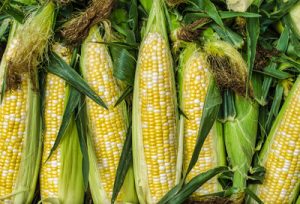Machinery and Equipment Guide
 Machinery and equipment required for sweet corn production will vary by a grower’s preferred production method and operation size. The following discussion shares basic machinery and equipment needs for sweet corn production. Depending on a grower’s operation size, expertise and previous machinery investments, the grower must determine whether to purchase and operate the equipment, engage a custom service provider or possibly rent and operate the necessary equipment.
Machinery and equipment required for sweet corn production will vary by a grower’s preferred production method and operation size. The following discussion shares basic machinery and equipment needs for sweet corn production. Depending on a grower’s operation size, expertise and previous machinery investments, the grower must determine whether to purchase and operate the equipment, engage a custom service provider or possibly rent and operate the necessary equipment.
Machinery and Equipment Needs
Sweet corn production, especially on small operations, typically has limited equipment requirements. Also, producers may already have most of the equipment required because this equipment has other on-farm uses.
Site preparation and planting equipment needs depend on the selected production model. Producers can choose from conventional tillage, minimum tillage or no-till practices. The machinery requirements table below considers equipment needs for conventional tillage and minimum tillage models. For production methods that use conventional tillage, equipment options include a moldboard plow, chisel and disk. At planting, a vacuum air planter is a good choice.
Minimum-till sweet corn production would conserve time, labor and soil moisture content. However, it wouldn’t be well-suited until soil temperatures warm. In this model, producers may begin with a minimally tilled planting site prepared with secondary tillage equipment. Then, a no-till planter would seed the sweet corn field.
Plasticulture can support early crop development. If producers adopt plasticulture production, then they can plant sweet corn and then lay the plastic. Alternatively, if they lay the plastic first, then they would need a special planter that could break through the plastic mulch.
To fertilize sweet corn planting sites, banding or broadcast applications are options. Penn State Extension suggests that banded applications are preferable to broadcast applications. If a fertility program includes sidedress nitrogen applications, then an operation would need equipment that could supply the sidedress applications.
When applying insecticides to manage pest populations, producers may choose high-boy sprayers or mist sprayers as equipment options. The sprayer must fit with sweet corn plant structure. The selected sprayer should enable the producer to direct insecticides to the ear zone. For weed control, producers may consider applying herbicides or cultivating the area.
To irrigate sweet corn fields, producers may choose from several irrigation procedures. As lines laid down sweet corn rows, drip irrigation can easily meet irrigation and fertigation needs. However, solid set sprinklers and traveling guns represent other irrigation options.
At harvest, producers may choose to employ hand labor, or they may use a mechanical harvester. Mechanical harvesters would be best suited for supersweet varieties. Three-point hitch and self-propelled mechanical harvesters are options. When using a mechanical harvester, the picked sweet corn may have shorter shanks and lighter colored husks, which help to conserve moisture if the corn is stored. Penn State Extension cautions that producers generally need at least 10 acres of sweet corn to justify purchasing a mechanical harvester.
In most cases, sweet corn producers choose to harvest sweet corn by hand at three- to four-day intervals. Human labor is important for harvest models that use both mechanized equipment and hand labor. Workers can scan harvested sweet corn for damage and serve as quality control. A truck or wagon will be necessary to move freshly harvested sweet corn from the field to the precooling area.
For sweet corn that’s shipped to wholesale or distant markets or that’s meant for short-term storage, producers will need to cool sweet corn ears after harvest. Production facilities should be equipped to precool sweet corn using a cold water shower or cold water immersion, store precooled sweet corn in a refrigerated truck or room and distribute cooled sweet corn in a refrigerated truck.
Equipment and Machinery Needs for Sweet Corn Production
|
Tillage |
No-Till |
|
|
Tractor |
X |
|
|
Moldboard plow |
X |
|
|
Chisel |
X |
|
|
Disk |
X |
|
|
Secondary tillage |
X |
|
|
Air vacuum planter |
X |
|
|
No-till planter |
X |
|
|
Fertilizer spreader |
X |
X |
|
Fertilizer sidedresser |
X |
X |
|
High-boy sprayer |
X |
X |
|
Broadcast sprayer |
X |
X |
|
Drip irrigation tape |
X |
X |
|
Wagon |
X |
X |
|
Precooling system |
X |
X |
|
Cold storage area |
X |
X |
|
Refrigerated truck |
X |
X |
Sources
Duffy, Mike and Jodi Calvert. 2010. Enterprise Budget: Sweet Corn . Iowa State University. Ames, IA 50011.
Jett, Lewis W. 2006. Growing Sweet Corn in Missouri. University of Missouri Extension. Columbia, MO 65201.
Mayberry, Keith S. and Herman Meister. 2003. Sample Cost to Establish and Produce Sweet Corn. University of California. Davis, CA 95618.
Orzolek, Michael D., Lynn F. Kime and Jayson K. Harper. 2011. Sweet Corn Production. Penn State Extension. University Park, PA 16802.
Schultheis, Jonathan. 1998. Sweet Corn Production. North Carolina Cooperative Extension. Raleigh, NC 27695-7602.